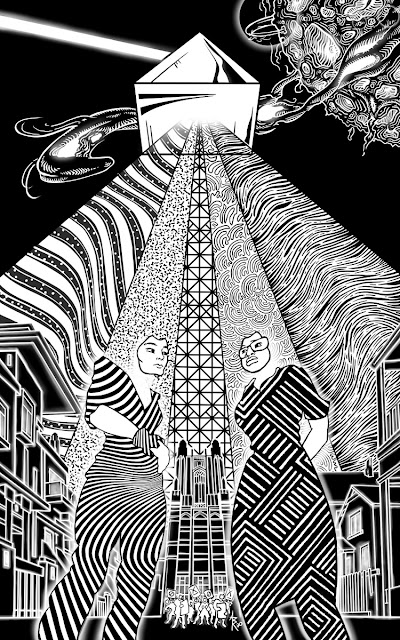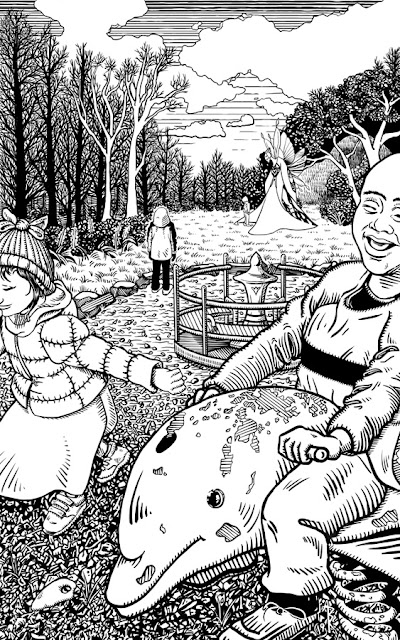 |
| Title Page for Back 2 OmniPark. |
For most of the weekend trips I took with my friends to OmniPark there was drinking. This is before theme parks started checking your bags at the gate and you could still gain entrance with a water bottle full of vodka. You didn't want to get completely shitfaced on the grounds. There were too many kids. And while there wasn't a strong security presence on the premises, you always had the sense you were being watched. That said, being a little high made the rides more enjoyable. The Nebula Quest in particular could be quite jarring in parts and taking something to loosen you up beforehand helped. Also, OmniPark themes were heavily rooted in science and you needed at least a modicum of wits to navigate them.
Tales from OmniPark (the first OmniPark anthology) featured a number of artifacts and documents interspersed between the pages of the stories. Some of these elements were repurposed and reused throughout the book. With Back 2 OmniPark Ben wanted fresh content for each artifact. We spent about a week brainstorming ideas and researching theme park equipment and merchandise, putting an OmniPark twist on ideas. In total we came up with about 30 artifact concepts that could have made it into the book. With space and time limited only about 10 made it into print. My favorite of the unused ideas was a baby's onesie sold in The Realm of the Cell inked with the phrase, "The Focus is Mitosis." That one always made me smile.
Ben and I workshopped several of the artifacts, but there were a few that were eventually printed exactly as I presented them. The documents in the book were mostly unchanged.
One artifact that surprised me was the little known (perhaps fake) scientific volume by Charles Darwin, "The Terrifying Awe of Unnatural Selection on the Development of Man and Related Species." We had a photo of the book which featured the text on the spine. But the editors asked if we could shift the focus to the front cover. None of us actually own a physical copy of the book and mysteriously it hasn't been available for purchase online since about 2014. The solution? Using the perspective tools available in Photoshop. I had to manipulate and pull the existing image to make it appear the book had changed position and angle, ...And what surprised me was how well that manipulation worked.
 |
| Questionable Documents. |
In addition to the artifacts we brainstormed, Ben had a number of photos taken from inside the park and a few pictures of the original managerial staff and engineers, which Dalton Teague termed his Technosophers. Once we had the artifacts ready for presentation it was time to move to the next phase, design elements.
One of Ben's favorite anthologies was Lovecraft's Monsters, edited by the unstoppable Ellen Datlow with art and design by John Coulthart. This book was a constant touchstone for Back 2 Omnipark. The primary design elements that needed to be created were a title graphic, contents page, chapter title graphic, and the a detailed map of Omnipark to sit at the beginning of the book. There was a little more time to work on these elements than there had been for the illustrations, and I was able to add a lot more shadow and detail.
 |
| Sketches for illustrations and artifacts. |
The next phase was layout. Again, I'd designed hundreds of pages for magazines, but this was my first book. I'm happy to say, for the most part, all went well. I owe a lot of thanks to Adobe InDesign, for making the process simple. Designing the interior of a book goes fast, especially compared to a magazine. Magazines have lots of pictures, graphic elements, and advertisements that push and take up space with the text. But in a book, once the text starts, it rarely get's interrupted. If there was a trick to the process it was trying to minimize "widows and orphans." Preparing and converting the book, with all its illustrations and artifacts, for the ebook format was also a grand learning experience. I'm happy to brag that most of the files uploaded into the printers website with few red flags or kickback.
The editors and I designed the back cover layout, a poster, a few t-shirts and then we were off to the printers.
 |
| 15 Illustrations for 15 Stories in Back 2 OmniPark |
Back 2 OmniPark is available for purchase on Amazon and where books are commonly sold.




































